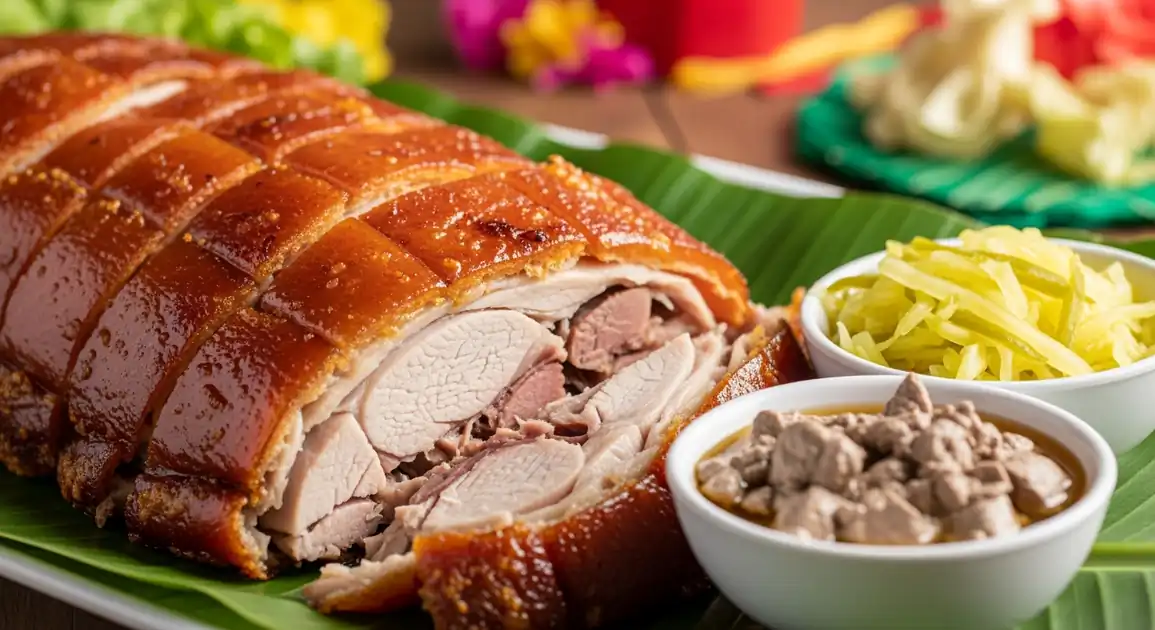Lechon (Roasted Pig)
Lechon Baboy / Litson

Description
Bohol's Lechon scene is influenced by nearby Cebu but also has its own local character. You'll find Lechon readily available, especially for celebrations and in markets. The style often leans towards the flavorful, herb-stuffed Visayan tradition, potentially less reliant on heavy sauces compared to Manila style.
Dietary Information
Serving information
Serving style
Likely served similar to Cebu style, emphasizing the natural flavor of the roasted pig, possibly with a simple vinegar dip ('sawsawan') rather than thick liver sauce.
Quick facts
Market vendors: Morning until sell-out (early afternoon). Eateries: Lunch hours. Fiesta stalls: Duration of the fiesta.
Safety Tips
What to Look For
-
Incredibly crispy, crackling skin
This is the primary indicator of freshly roasted, high-quality Lechon. Soggy skin means it's old or improperly stored.
-
Moist, juicy-looking meat
The meat should not appear dry or tough. Look for visible succulence when carved.
-
Vendor carves from a whole pig upon ordering
Ensures greater freshness compared to pre-carved portions sitting out.
-
High customer turnover
Busy stalls sell Lechon quickly, ensuring the product doesn't sit for too long.
-
Clean serving area and utensils
Basic food hygiene is crucial. Check for clean chopping boards, knives, and serving practices.
What to avoid
-
Soggy, rubbery, or soft skin
Indicates the Lechon is old or has been stored improperly, losing its essential crispiness.
-
Dry, stringy-looking meat
Suggests overcooking or that the Lechon has been sitting for too long.
-
Pre-carved portions sitting uncovered at room temperature for extended periods
Increases risk of bacterial contamination, especially in warm climates.
-
Visible flies or pests around the food
Major hygiene red flag.
-
Vendor handles money then food without washing hands/changing gloves
Risk of cross-contamination.
Price information
Price range
Budget tips
- Check prices in local markets like Tagbilaran City's central market.
- Ordering directly from local roasters ('lechoneros') for events might be economical.
- Prices generally align with Cebu, possibly slightly lower.
Value indicators
- Crispy skin is paramount.
- Aromatic meat, suggesting good stuffing.
- Vendor cleanliness and local popularity.
- Moisture level of the meat.
Where to Find This Dish
Tagbilaran City Markets
The main public market in Tagbilaran City is a likely place to find Lechon vendors selling by weight.
Tagbilaran City Central Public Market
Morning, Lunch
Local Eateries ('Karenderia')
Some local eateries might offer Lechon, especially on weekends or special occasions.
Throughout towns and Tagbilaran
Lunch
Fiesta Venues
During local town fiestas, Lechon stalls are almost guaranteed to be present.
Town plazas during fiestas
During fiesta days
Vendor Tips
- Ask locals for recommendations on the best Lechon vendors in town.
- Inquire if their style is 'Bisaya' (Visayan/Cebu style) to gauge flavor profile.
- Check for crispiness – don't buy if the skin looks soggy.
- If ordering whole lechon for an event, find trusted local 'lechoneros'.
How to Order
Regional Variations
-
Local Herb Variations
(Lokal na Rekado)
Stuffing might include locally available herbs or slight variations on the standard Cebuano spice mix.
-
Availability Linked to Fiestas
(Panahon ng Piyesta)
While available year-round, visibility and availability might surge significantly during local fiesta periods.
Cultural context
History
Roasting pigs predates Spanish colonization, but the specific 'Lechon' tradition as known today, including the name, has significant Spanish influence, merging indigenous roasting techniques with European fiesta culture. It became deeply ingrained as a symbol of hospitality, celebration, and community gathering throughout the archipelago, evolving regional variations like the distinct Cebu and Manila styles.
Local significance
Lechon is central to Boholano celebrations, reflecting Filipino fiesta culture common throughout the Visayas. Strong community ties are often celebrated around a shared Lechon.
Eating customs
- Likely follows Visayan custom of minimal sauce to appreciate meat flavor.
- Eating with rice is standard.
- Enjoying the crispy skin is a highlight.